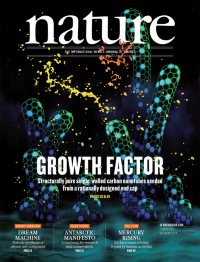Volume 512
-
No. 7515 28 August 2014
In a study of the extent to which new patterns of neural activity can be generated through learning, Aaron Batista and colleagues examine neuronal network reorganization in Rhesus macaques learning to control a computer cursor using different patterns of activity in motor cortex. Some new neural activity patterns were more easily generated than others � corresponding to more easily learned tasks � and these could be predicted mathematically from the network topology at the beginning of the experiment. The authors speculate that the results provide a basis for a neural explanation for the balance between adaptability and persistence in action and thought. Cover: Jasiek Krzysztofiak/Nature
-
No. 7514 21 August 2014
John Sibbicks painting imagines the iconic Early Jurassic basal mammals, Morganucodon and Kuehneotherium, hunting their favoured prey on the small island that they shared in what is now Glamorgan, southern Wales. The very earliest mammals, living in the Late Triassic and Early Jurassic around 200 million years ago, were small and are often presumed to have been generalized insectivores. Now a close study of Morganucodon and Kuehneotherium shows that niche partitioning and dietary specialization were well under way even at that early date. Analysis of tooth wear and jaw biomechanics shows that whereas Morganucodon had powerful jaws, capable of crushing hard prey such as beetles, Kuehneotherium was adapted for snapping at softer prey, such as the scorpion flies illustrated here. Cover: www.johnsibbick.com
-
No. 7512 7 August 2014
The electronic properties of single-walled carbon nanotubes (SWCNTs) are extraordinarily sensitive to their precise structure. To exploit their technological potential fully, samples containing only one SWCNT type are needed. Juan Ramon Sanchez-Valencia et al. have combined synthetic chemistry with materials engineering to develop a strategy that, with further optimization, could provide a route to nanotube-based materials for use in light detectors, photovoltaics, field-effect transistors and sensors. They use a surface-catalysed cyclodehydrogenation reaction to fold rationally designed precursor molecules deposited on a Pt(111) surface to produce end caps� that act as seeds for the growth of defect-free and structurally pure SWCNTs. The technique requires only modest temperatures and is fully compatible with todays complementary metal oxide semiconductor technologies. Cover: Konstantin Amsharov.




